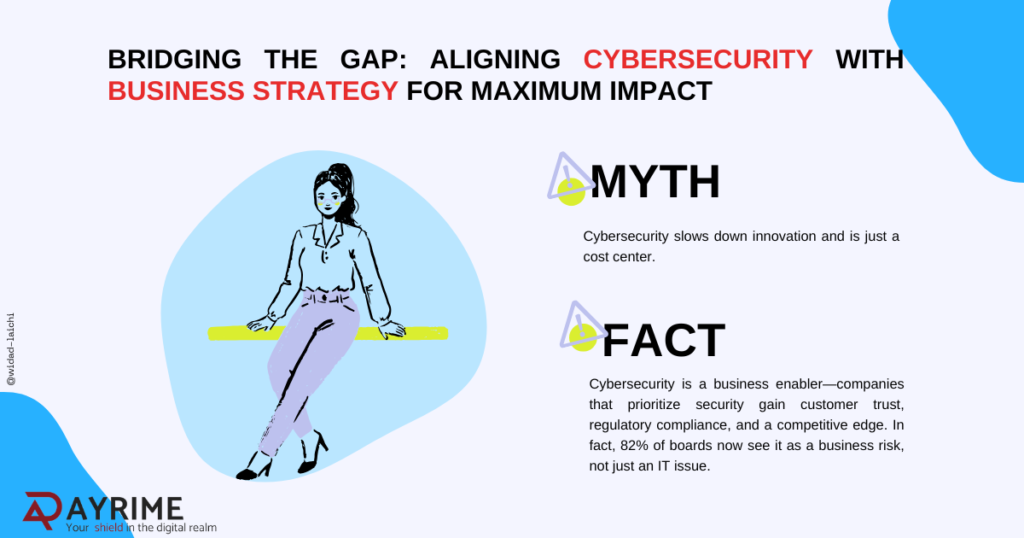As a Chief Information Security Officer (CISO) or an information security professional, you are no stranger to the challenge of aligning security with business objectives. In today’s digital-first world, security is not just about preventing breaches—it is about enabling business growth, ensuring compliance, and fostering customer trust. Yet, many security leaders struggle with gaining executive buy-in, justifying security investments, and integrating security seamlessly into business strategy.
Balancing security priorities with business goals requires more than just technical expertise; it demands strategic thinking, risk management, and collaboration across departments. How do you ensure security supports rather than hinders business initiatives? How can you align security efforts with the company’s mission while demonstrating measurable value?
In many organizations, a disconnect between technical objectives and strategic business goals has created a significant gap between cybersecurity teams and executive leadership. This breakdown in communication, often due to a lack of shared understanding, hinders collaboration. However, bridging this gap is entirely possible.
This blog explores these challenges and provides actionable steps to help security leaders embed security into the core of their organization’s strategic vision.

Why Align Security with Business Strategy?
1. Security as a Business Enabler
Security is often viewed as a cost center rather than a strategic asset. However, when integrated effectively, security strengthens business resilience, supports digital transformation, and fosters trust among customers, partners, and stakeholders.
2. Compliance and Regulatory Requirements
Businesses operate in a landscape of stringent data protection laws, industry regulations, and compliance standards such as GDPR, HIPAA, and ISO 27001. Aligning security with business objectives ensures that compliance is proactive rather than reactive, avoiding legal penalties and reputational damage.
3. Risk Mitigation and Resilience
Aligning security with business strategy enables organizations to anticipate, assess, and mitigate risks efficiently. A well-integrated security framework allows businesses to continue operating seamlessly even in the face of cyber threats, breaches, or other disruptions.
4. Competitive Advantage and Customer Trust
In an era where customers demand transparency and security, businesses that prioritize security as part of their value proposition can differentiate themselves from competitors. Trust is a critical asset, and companies that ensure data privacy and security gain long-term loyalty.
Aligning Security with Business Strategy: A Practical Approach
Understanding the Business: Mission, Goals, and Culture
A strong security strategy starts with a clear grasp of the organization’s mission, objectives, and values. Security leaders must go beyond technical concerns and engage with business stakeholders to understand what drives the company forward. This means identifying how security can safeguard critical business processes while also creating opportunities for growth and innovation.
Security should not be an obstacle to progress—it should be a catalyst. If agility and innovation are core company values, security policies must support these principles rather than impose rigid constraints. By aligning security initiatives with the organization’s culture, security leaders ensure that protection measures enhance rather than hinder business operations.
How Security Powers Business Success
Security is more than just risk mitigation—it’s a business enabler. A well-integrated security strategy ensures that business goals can be pursued without disruption or unnecessary risk. For example, if a company is expanding into new markets, security leaders must anticipate potential challenges such as regulatory requirements, data protection laws, and supply chain vulnerabilities. Addressing these proactively ensures smoother expansion with minimal risk.
Security also plays a critical role in improving efficiency and innovation. By automating routine security tasks and streamlining access to resources, security teams can help employees work faster and smarter. Additionally, fostering a culture where employees understand and prioritize security can lead to innovative solutions that enhance both business performance and cybersecurity resilience.
Protecting Reputation and Customer Trust
it is surprise to no one that a single data breach can severely damage a company’s reputation and erode customer confidence. Strong security measures not only protect sensitive data but also serve as a competitive differentiator. Organizations that can demonstrate a commitment to cybersecurity are more likely to build trust with customers, partners, and investors. Transparency about security initiatives and achievements can reinforce this trust and strengthen brand loyalty.
Security as a Competitive Advantage
To measure the impact of security on business success, organizations must evaluate their capabilities against industry standards. Security teams that leverage advanced analytics, automation, and threat intelligence can provide valuable insights that influence business decisions. Collaboration with product development and marketing teams can also create secure, privacy-focused offerings that attract customers and set the company apart from competitors.
Measuring Security’s Impact on Business Success
Defining Meaningful Security Metrics
Effective security metrics go beyond technical statistics—they must directly support business objectives and drive informed decision-making. Instead of just counting vulnerabilities, organizations should track how quickly critical risks are remediated or the percentage of systems exposed to known threats. These insights provide a clearer view of risk exposure, helping leaders allocate resources more effectively and prioritize security efforts where they matter most.
Aligning Security Metrics with Business Performance
Security should be measured not in isolation but in relation to broader business goals. Close collaboration between security and business teams ensures that security metrics reflect key drivers of success. For example, if customer trust is a priority, tracking security-related complaints or measuring how security influences purchasing decisions can highlight its business impact. Demonstrating security’s role in achieving business goals strengthens executive support and justifies investment in security initiatives.
Establishing Benchmarks for Continuous Improvement
To maintain a strong security posture, organizations must benchmark their performance against industry standards, regulatory requirements, and internal goals. Regular assessments help identify gaps, measure progress, and refine strategies. Engaging in industry information-sharing and benchmarking initiatives also provides valuable insights into evolving threats and best practices, keeping the organization ahead of emerging risks.
Streamlining Data Collection and Reporting
For security metrics to be effective, they must be based on accurate, timely data. This requires collaboration across security, IT, and business units to ensure relevant data is collected, analyzed, and communicated efficiently. Automating reporting processes minimizes manual effort while keeping key stakeholders informed. Additionally, continuously refining security metrics in response to changing business needs ensures alignment with strategic objectives and keeps security efforts relevant and impactful.
Key Steps to Align Security with Business Strategy
1. Understand Business Objectives and Risk Appetite
Security leaders must collaborate closely with business executives to understand the company’s mission, goals, and risk tolerance. This understanding allows security teams to tailor their strategies to protect critical business assets while enabling growth.
2. Integrate Security into Business Planning
Security should not be an afterthought but an integral part of business planning. From product development to mergers and acquisitions, security considerations should be embedded in decision-making processes to mitigate potential risks early on.
3. Adopt a Risk-Based Approach
Rather than applying a one-size-fits-all security model, businesses should focus on identifying and prioritizing risks based on their impact on key business functions. A risk-based approach helps in allocating security resources effectively, ensuring that the most critical areas receive the highest level of protection.
4. Foster a Security-First Culture
Security is not solely the responsibility of IT or cybersecurity teams—it is a company-wide effort. Organizations should invest in regular security awareness training, establish clear policies, and encourage employees to adopt a security-first mindset in their daily activities.
5. Align Security Metrics with Business KPIs
To demonstrate the value of security investments, organizations should measure and communicate security performance in business terms. Security leaders should align security KPIs with business objectives, such as revenue growth, customer retention, and operational efficiency.
6. Leverage Technology and Automation
Implementing modern security solutions such as AI-driven threat detection, identity and access management (IAM), and cloud security platforms helps businesses enhance security while improving operational efficiency. Automation reduces human errors and streamlines security processes.
7. Establish Governance and Continuous Improvement
Security alignment is not a one-time effort but an ongoing process. Businesses should establish governance frameworks, conduct regular security assessments, and continuously adapt security strategies to evolving threats and business needs.
Real-World Examples of Security and Business Alignment
- Financial Sector: A global bank integrates security into its digital banking transformation, ensuring secure transactions while enhancing customer experience.
- E-commerce: An online retailer incorporates security as a key differentiator by offering end-to-end encrypted transactions and secure payment processing.
- Healthcare: A hospital aligns its cybersecurity strategy with patient safety, ensuring compliance with HIPAA regulations while safeguarding sensitive medical records.
Final Thoughts
Aligning the security function with business strategy, goals, mission, and objectives is no longer optional—it is a necessity. Organizations that proactively integrate security into their business framework gain resilience, regulatory compliance, customer trust, and a competitive advantage. By fostering collaboration, adopting a risk-based approach, and leveraging technology, businesses can transform security from a protective function into a strategic asset that drives growth and innovation.
Security is not just about protection; it is about enabling the future. Organizations that understand this will thrive in an increasingly complex and digital world.


